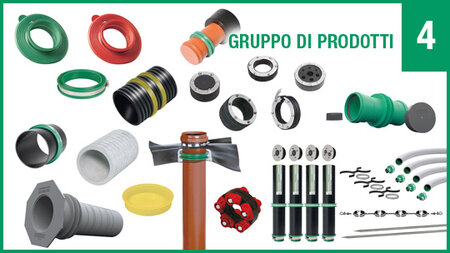Passaggi impermeabili per tubi, per manufatti a pressione
Passaggi impermeabili per tubi, per manufatti e accessori

Sistema di connessione alla casa per i collegamenti elettrici, idrici e di comunicazione Testato secondo DVGW VP 601 (capitolo 4.5...
I collari di tenuta sigillano in modo sicuro tubi e cavi in plastica, acciaio, cemento e argilla vetrificata contro un'elevata col...
Tubi cavi in PVC o fibrocemento o in acciaio inossidabile per la realizzazione di tubi o condutture in una costruzione....
Offriamo sistemi di penetrazione nella parete che possono essere inseriti a tenuta d'acqua nell'edificio....
Offriamo penetrazioni per solette nella versione arancione-marrone come sistemi in PVC-U (KG) o come tubi in polipropilene (PP), c...
Inserti di guarnizione V2A in acciaio inox per il rivestimento di tubi e fori di carotaggio. Ne offriamo diversi tipi....
Tenuta modulare - Preassemblato - Installazione facile e veloce - Testata fino a 30 m di colonna d'acqua - Può essere retrof...
Sigillante plastico, resistente al vapore e all'acqua, per la protezione dall'acqua di condotte e cavi sotto il livello del suolo....
Qui trovate gli accessori necessari...
Che ruolo hanno le entrate nelle costruzioni in cemento armato?
I requisiti per le strutture in calcestruzzo a tenuta stagna sono regolati dalla corrispondente linea guida DAfStb (linea guida WU). Oltre ai requisiti per la struttura in calcestruzzo in sé, vengono qui definiti i requisiti per l'impermeabilizzazione dei giunti e per gli ancoraggi o i punti di tensione delle casseforme. L'oggetto di questa linea guida è la progettazione e l'esecuzione della struttura in modo da soddisfare le proprietà d'uso e i requisiti d'uso specificati dal committente per quanto riguarda la funzione di tenuta all'acqua.
Un aspetto che non viene preso in considerazione dalla direttiva, ma che non deve essere trascurato per ottenere una struttura a tenuta stagna, è la sigillatura di tubi e cavi che passano attraverso il componente in calcestruzzo. Con le nostre diverse entrate in casa, offriamo la soluzione giusta per quasi tutte le situazioni di installazione, indipendentemente dal fatto che si tratti di una penetrazione di tubi, di un tubo di rivestimento o di un'entrata in casa. Se l'acqua sta già penetrando, è possibile utilizzare un composto sigillante per l'impermeabilizzazione.
A cosa servono le voci della casa?
Ogni volta che le tubature o altre linee passano attraverso componenti in calcestruzzo, devono essere sigillate contro l'ingresso di acqua e/o gas come il gas metano o il gas radon radioattivo talvolta presente nel terreno.
Poiché i tubi e i cavi hanno proprietà materiali diverse da quelle del calcestruzzo e quest'ultimo si restringe con l'indurimento, vi è il rischio di circolazione nelle intersezioni tra tubi e cavi e il calcestruzzo. L'acqua o i gas possono penetrare nell'edificio e creare un rischio di danni alla struttura o addirittura alla salute delle persone che vi abitano.
Come vengono installate le entrate delle case?
A seconda del tipo di ingresso della casa, viene installata nella cassaforma prima del getto del calcestruzzo o incorporata nell'area della base da gettare. L'installazione successiva in un foro di carotaggio è possibile anche utilizzando le nostre guarnizioni per spazi anulari e le catene a maglie. La penetrazione di un tubo o di altre linee di supporto può essere sigillata utilizzando i collari a parete.
Esistono requisiti speciali per l'impiego nel settore agricolo. A questo scopo, abbiamo in programma il nostro collare da parete JGS (RONDO Protect).





 inglese
inglese








